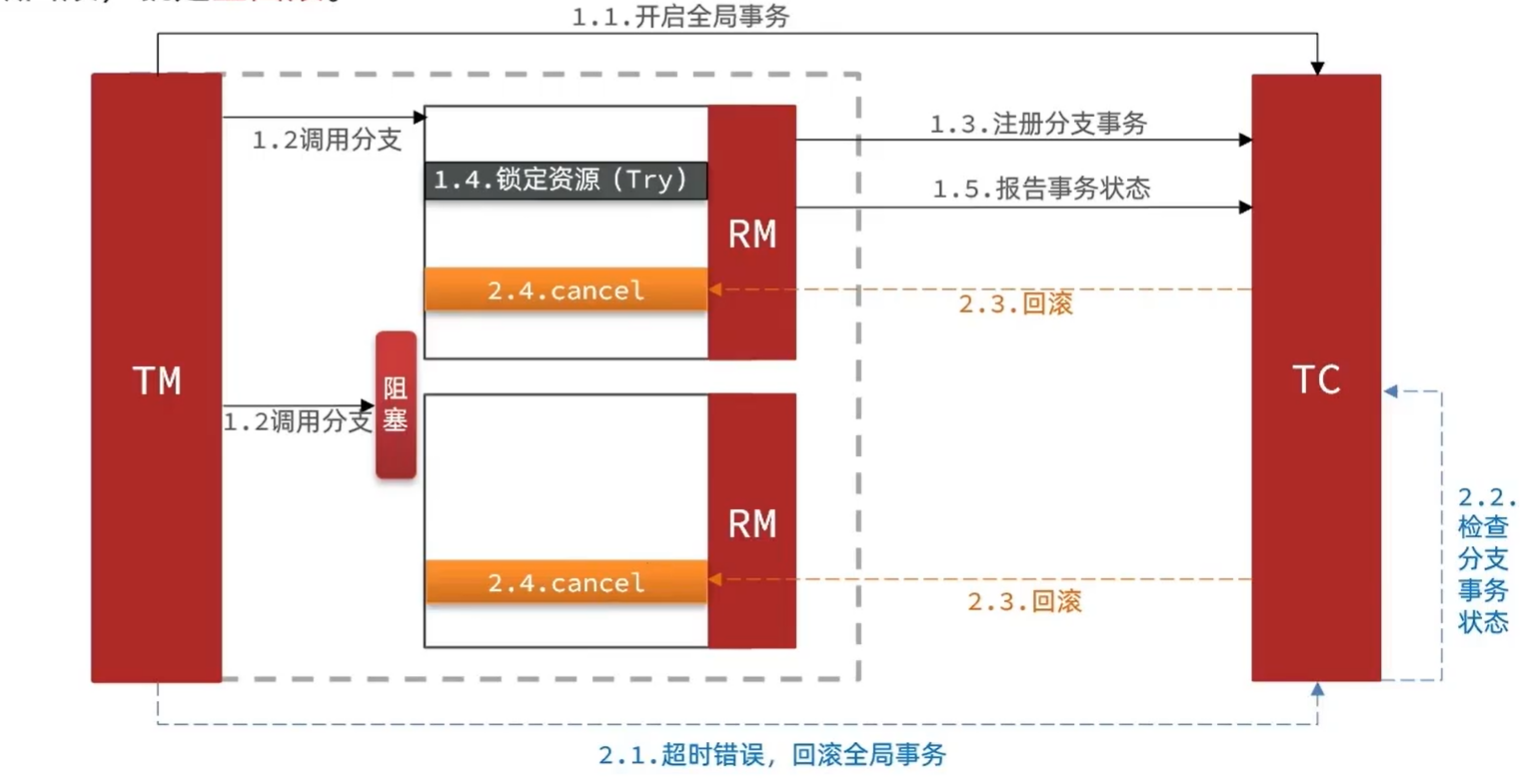整合Seata之使用TCC模式
cv大魔王 2024-02-11 SpringCloudSpringCloudAlibaba 分享
TCC 完全不依赖底层数据库,能够实现跨数据库、跨应用资源管理,可以提供给业务方更细粒度的控制,性能上可以说是最好的,缺点是需要人工干预,三个阶段全都需要人工编写。(TCC保障最终一致性)
- Try:资源检查和预留
- Confirm:业务执行和提交
- Cancel:预留资源的释放

# 空回滚与业务悬挂
空回滚:资源还没有锁定,就执行回滚;即有两个RM,RM1锁定资源单出现问题需要回滚释放资源,但是RM2还没有锁定不需要释放资源,但是如果你也释放了就是空回滚。

业务悬挂:执行业务回滚后,又执行Try即锁定资源,导致资源永远被锁定不被cancel或Confirm。
# 业务举例

# 声明TCC接口
@TwoPhaseBusinessAction:注解在哪个方法上,就说明该方法使用的是TCC模式- name:和方法名称相同接口
- commitMethod:提交代码(删除锁定资源)的方法名称
- rollbackMethod:回滚代码(恢复锁定资源)的方法名称
package cn.itcast.account.service;
import io.seata.rm.tcc.api.BusinessActionContext;
import io.seata.rm.tcc.api.BusinessActionContextParameter;
import io.seata.rm.tcc.api.LocalTCC;
import io.seata.rm.tcc.api.TwoPhaseBusinessAction;
@LocalTCC
public interface AccountTCCService {
@TwoPhaseBusinessAction(name = "deduct", commitMethod = "confirm", rollbackMethod = "cancel")
void deduct(@BusinessActionContextParameter(paramName = "userId") String userId,
@BusinessActionContextParameter(paramName = "money")int money);
boolean confirm(BusinessActionContext ctx);
boolean cancel(BusinessActionContext ctx);
}
编写实现类:
package cn.itcast.account.service.impl;
import cn.itcast.account.entity.AccountFreeze;
import cn.itcast.account.mapper.AccountFreezeMapper;
import cn.itcast.account.mapper.AccountMapper;
import cn.itcast.account.service.AccountTCCService;
import io.seata.core.context.RootContext;
import io.seata.rm.tcc.api.BusinessActionContext;
import lombok.extern.slf4j.Slf4j;
import org.springframework.beans.factory.annotation.Autowired;
import org.springframework.stereotype.Service;
import org.springframework.transaction.annotation.Transactional;
@Service
@Slf4j
public class AccountTCCServiceImpl implements AccountTCCService {
@Autowired
private AccountMapper accountMapper;
@Autowired
private AccountFreezeMapper freezeMapper;
@Override
@Transactional
public void deduct(String userId, int money) {
// 1.获取事务id
String xid = RootContext.getXID();
// 2.扣减可用余额
accountMapper.deduct(userId, money);
// 3.记录冻结金额,事务状态
AccountFreeze freeze = new AccountFreeze();
freeze.setUserId(userId);
freeze.setFreezeMoney(money);
freeze.setState(AccountFreeze.State.TRY);
freeze.setXid(xid);
freezeMapper.insert(freeze);
}
@Override
public boolean confirm(BusinessActionContext ctx) {
// 1.获取事务id
String xid = ctx.getXid();
// 2.根据id删除冻结记录
int count = freezeMapper.deleteById(xid);
return count == 1;
}
@Override
public boolean cancel(BusinessActionContext ctx) {
// 0.查询冻结记录
String xid = ctx.getXid();
AccountFreeze freeze = freezeMapper.selectById(xid);
// 1.恢复可用余额
accountMapper.refund(freeze.getUserId(), freeze.getFreezeMoney());
// 2.将冻结金额清零,状态改为CANCEL
freeze.setFreezeMoney(0);
freeze.setState(AccountFreeze.State.CANCEL);
int count = freezeMapper.updateById(freeze);
return count == 1;
}
}
评论区
暂无评论~~
